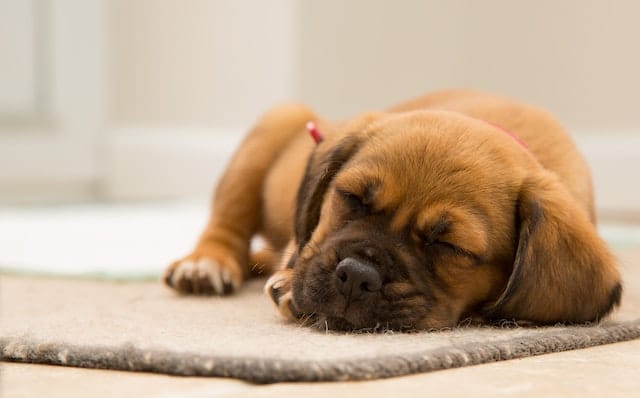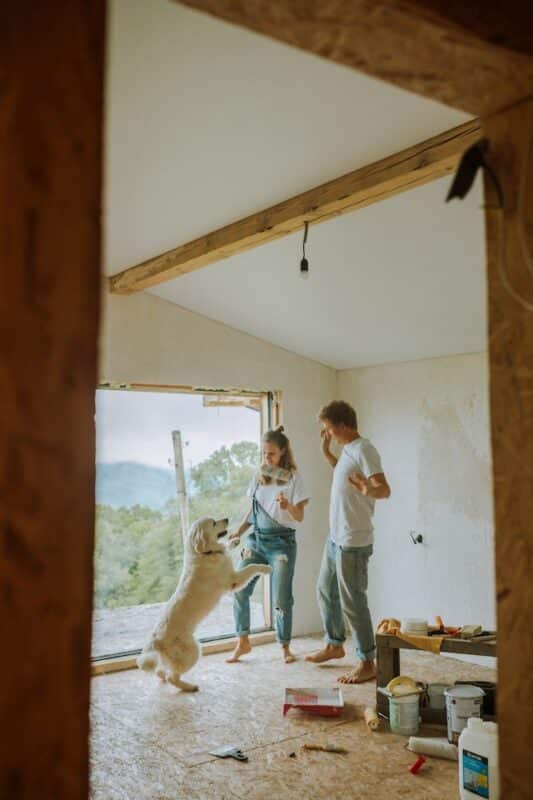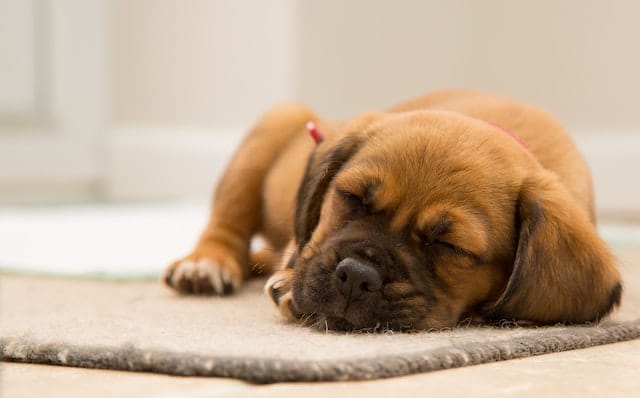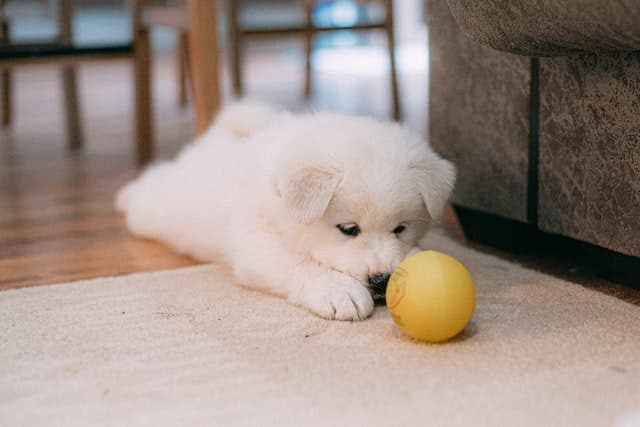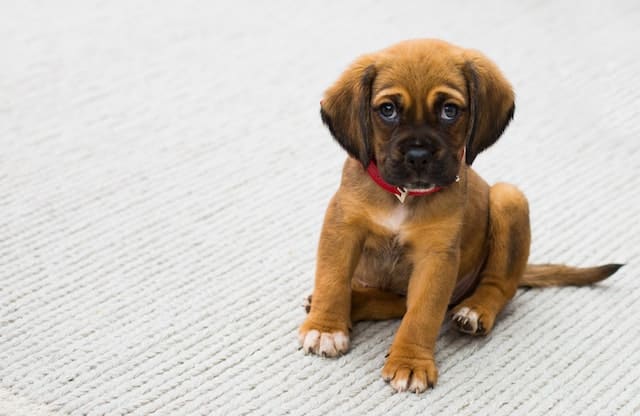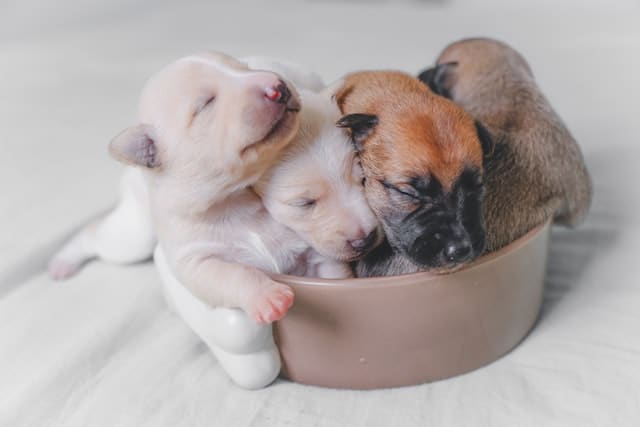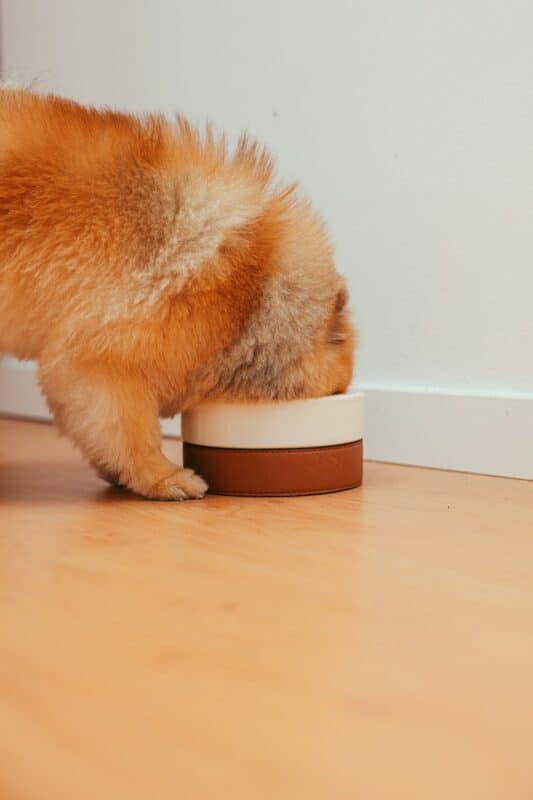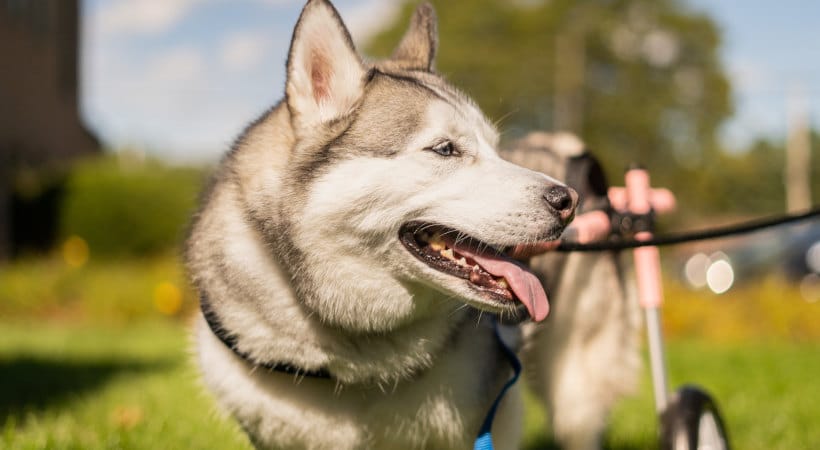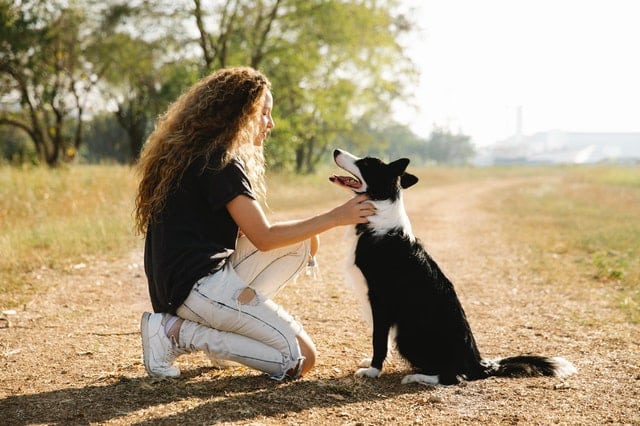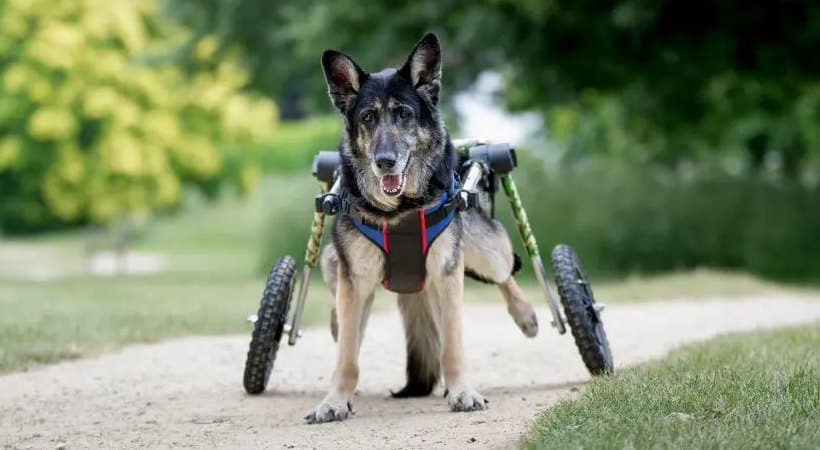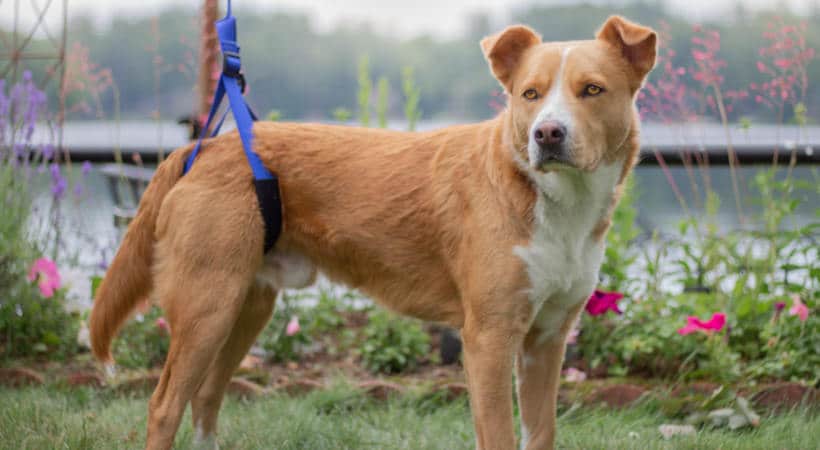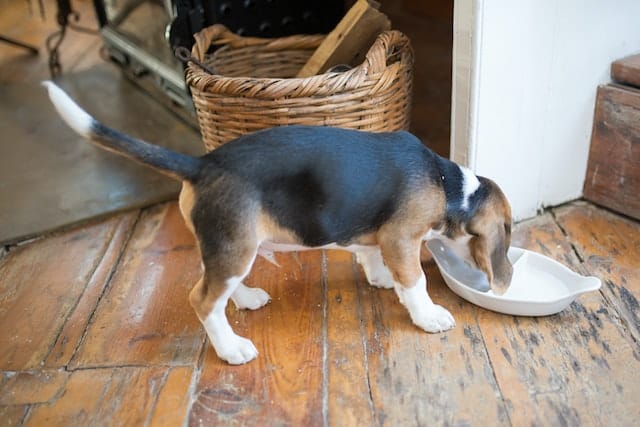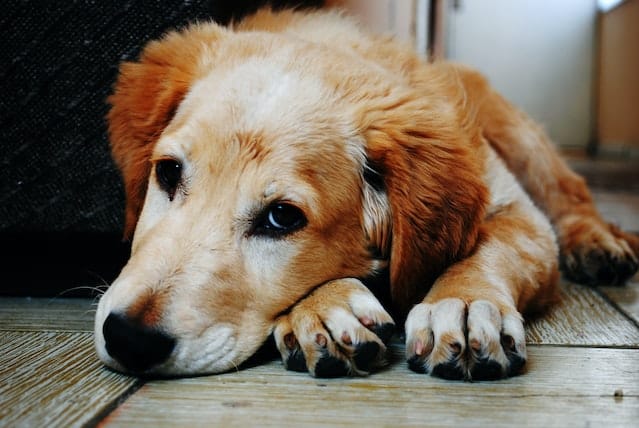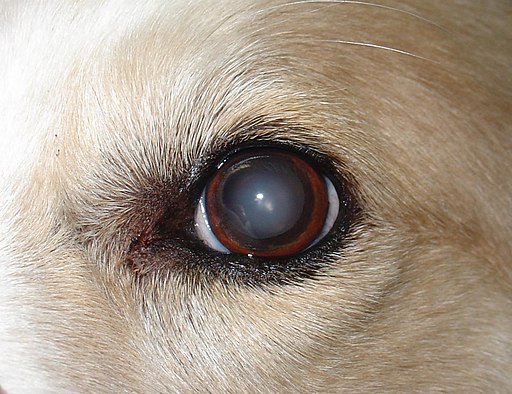Taking care of a puppy has 4 basic tasks:
- Feeding
- Hygiene
- Training
- Bonding
How to Take Care of A Puppy: Four Basic Steps
Feeding
Step 1: Talk to your vet
At this point in time, there are so many choices of dog food on the shelves that it can be a bit overwhelming choosing the best one for your new puppy. That’s why your very first step should be to talk with your vet about which food they recommend. Different breeds of puppy have different nutritional needs in the beginning of their life. A Great Dane puppy has very different nutritional needs than a Chihuahua puppy, as you can imagine! Your vet will be able to tell you exactly how much protein, fat and how many calories your puppy requires each day. Your vet can not only recommend a brand of food, but also help you determine the best feeding times and portion sizes.
Step 2: Set a schedule.
Most puppies will eat 3 times a day and gradually work their way to twice a day. Smaller dogs may eat 4 times a day. Having a consistent feeding schedule often helps with potty training. Talk to your veterinarian at your first appointment to determine the feeding schedule that will work best for you and your puppy.
Step 3: Set expectations.
Start early when it comes to training your puppy on the expectations in your home. Some dog owners, for example, require their dog to sit before they put the bowl down. It is easier to start with these expectations from the start than to try to change a habit that you and your puppy establish, so, if you have expectations for how your dog should behave at feeding times, start to show her and reinforce good behavior early.
Step 4: Provide fresh water at each meal time.
Fresh water is very important to have available at all times, so be sure to refill it at each meal time, and more often if your puppy finishes it sooner.
Tips
- Choose a high-quality puppy food brand and stick with it. Changing foods too quickly or frequently can cause stomach upset.
- Experts discourage “free feeding,” leaving a full bowl of food available to your dog at all times, because it promotes overfeeding and excessive weight gain.
Hygiene & Health
Step 1: Go outside.
It’s a good idea to take your puppy outside, at least long enough to go to the bathroom, first thing in the morning to avoid accidents. Be sure to praise your puppy as soon as she goes.
Have a designated “potty spot” so your puppy begins to associate that spot with going to the bathroom.
Step 2: Keep going outside!
Some puppies need to go out as often as every hour when they are first learning potty training. Others follow the “rule” of taking your puppy outside at intervals of the number of months of age plus one (so, a 3-month-old puppy could go out every 4 hours). Try to get your puppy outside before she really needs to go so that she gets lots of praise for going potty in the right place.
Step 3: Take frequent walks every day.
Walks are a good time for your puppy to use the bathroom, but they are also essential to your puppy’s health and behavior. Puppies have a lot of energy, and frequent walks help them burn some of that energy so they don’t destroy things in your house.
Maintaining a consistent walk schedule helps with potty training, as your puppy will come to get used to going out and to the bathroom at certain times. Try to get 60 minutes of walking in per day, divided up into 2 to 4 sessions.
Step 4: Visit your veterinarian.
Make an appointment with your veterinarian as soon as possible after bringing your puppy home. Your vet will perform a complete exam and give you plenty of information about how to take good care of your puppy, including vaccinations, follow-up visits, and when to have your puppy spayed or neutered.
Step 5: Groom your puppy.
Brush your puppy often. This is a great time for bonding while also keeping her coat and fur healthy. Also, keep your puppy’s nails trimmed to keep her comfortable and from damaging things in your home. If you aren’t comfortable doing this yourself, look for a good pet groomer in your area.
Your puppy will also need baths on occasion, especially as he explores his environment. You can do this at home or at a groomer.
Tips
- Be patient with accidents. Your puppy is learning.
- Make sure to use more positive reinforcement than negative.
- You will need to get up overnight to let your puppy go to the bathroom, at least in the beginning.
- Keep an eye out for signs of illness, such as vomiting/diarrhea, excessive tiredness, swollen abdomen, etc. Contact your vet if you notice anything that doesn’t seem right.
Training
Step 1: Set up a crate.
A crate provides a safe and comfortable place for your puppy to call his own. It’s important to remember that a crate isn’t a punishment, but rather a safe, calming place for your puppy.
Start with short amounts of time in the crate and gradually lengthen the time. Also, keep the door open throughout the day so your puppy can go there to relax or nap.
Step 2: Start with basic commands.
Simple commands like come, sit, down and stay can go a long way. Start with one at a time, show your puppy what to do and give him lots of praise through treats, petting and words to reinforce his behavior.
Step 3: Develop good leash habits.
Start with the leash early so your puppy becomes used to it as she gets older, and therefore faster and harder to catch. Some puppy owners find it helpful to practice with the leash in the house. Praise your puppy for walking next to you on the leash instead of pulling.
Step 4: Socialize your puppy.
Many recommend a puppy class with a qualified trainer as early as 7-8 weeks. Every family may not have the time or money for a class, though. So, be sure to expose your puppy to a variety of people, pets, and situations. Puppies have a lot to learn, and, if they haven’t been exposed to children playing in the neighborhood or other animals, for example, they are more likely to respond with aggression as they get older. Of course, use a leash when socializing to keep your puppy and others safe.
Tips
- Make sure the whole family is on board with the “rules” you set for your puppy.
- Don’t bend the rules just because your puppy is young. For example, sneaking a few tables scraps early on will just create a problem that is difficult to train your dog out of.
Bonding
Step 1: Pet your puppy.
It may seem obvious, but the simplest and possibly most effective way to bond with your puppy is to give him lots of affection. Petting is an easy and quick way to bond with your puppy throughout the day.
Step 2: Play!
Playing with your puppy is a great way to develop a connection while helping your puppy burn off some of that extra energy. It may take a little time to find what toys/games your puppy enjoys, but, keep it positive and fun, and you both will surely have a great time!
Tips
- Have designated toys instead of old shoes or stuffed animals. This can “train” your puppy to chew on things you don’t want her to chew on.
- Allow your puppy to bond with each member of your family, but be sure to supervise your puppy with children.
References
- Coates, J. (2012). Why Free-Feeding is the Wrong Choice for Most Dogs. Retrieved from https://www.petmd.com/blogs/nutritionnuggets/2012/feb/jcoates/free_feeding_is_wrong_choice_for_most_dogs-12694
- Drake Center for Veterinary Medicine. Puppy Care. Retrieved from https://www.thedrakecenter.com/services/dogs/puppy-care
- Fetch by WebMD. (2018). Taking Care of a Puppy. Retrieved from https://pets.webmd.com/ss/slideshow-taking-care-of-puppy
- Mckeeby, C. (2018). How to take care of a puppy: A new owner’s guide. Retrieved from https://www.care.com/c/stories/15173/how-to-take-care-of-a-puppy-a-new-owners-guide/
- Stregowski, J. (2020). Puppies 101: How to Care for a Puppy. Retrieved from https://www.thesprucepets.com/how-to-care-for-puppies-1117475
- Vet Street. (2014). Puppy Basics 101- How to Care for Your New Dog. Retrieved from http://www.vetstreet.com/care/puppy-basics-101-how-to-care-for-your-new-dog

